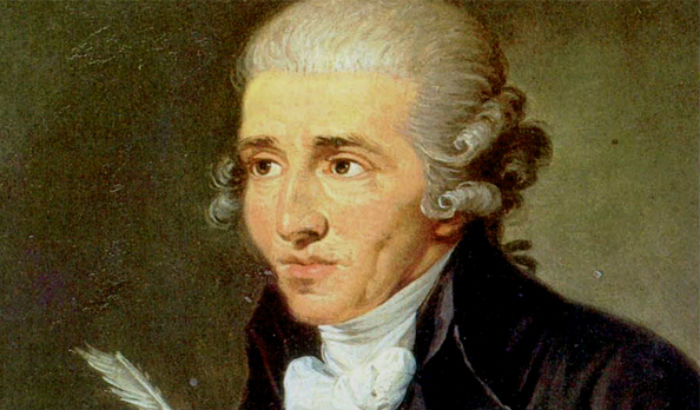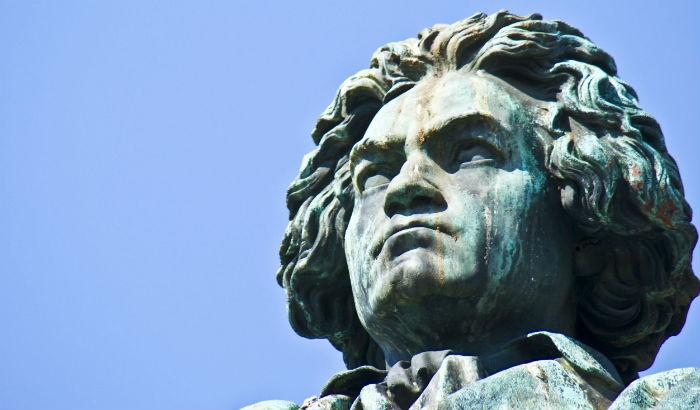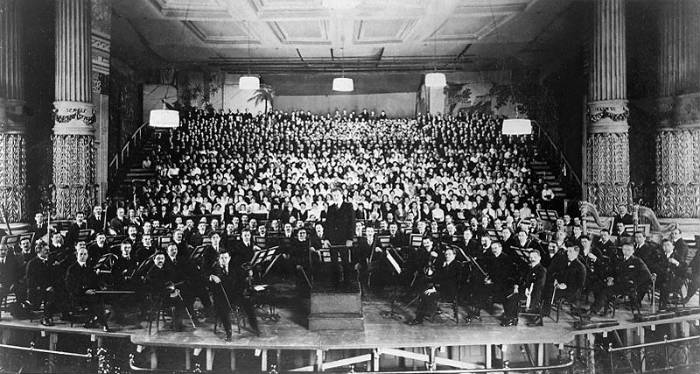When you hear the word ‘symphony’, you immediately think of something solemn and majestic such as Mozart’s Jupiter symphony, Beethoven’s Eroica (a current earworm of mine) or the opening notes of Dvorak’s New World Symphony.
Those are only a few examples and, we have to say, it’s quite challenging to give a straightforward definition of what a symphony actually is. Let’s just say that, starting in the 18th century, it came to indicate, at least empirically, the pinnacle of a composer’s achievement in terms of instrumental music.
For starters, the term symphony (and the corresponding forms in other languages) has gone a long way– it was not one of those pseudo ancient greek words coined by scholars from the 18th century in an era of remarkable progress in science and technology–telephone, for example, is one of those. After the BBC published a very expansive feature of the importance of the art of symphony in our culture, we decided to add some curious facts about the genre.
In ancient times, it was an abstract concept
In fact, we first find the word Symphonia (συμφωνία) in Greek philosophical and scientific treatises, where it meant “unison of sound”. In his Analytics, Aristotle defined Symphonia as a numerical ratio of high pitch and low pitch λόγος ἀριθμῶν ἐν ὀξεῖ ἢ βαρεῖ. For those who followed the lore of Pythagoras and his epigones, Symphonia pertained to the doctrine of the music of the spheres. Used in a non-musical context, Symphonia indicated harmony and agreement. Medieval music theory maintained the term Symphonia as “consonance” and opposed it to “diaphone,” which is dissonance.
A “symphony”, or “symphonie” also indicated some instruments

During the middle ages and the renaissance, there were several music instruments known as a symphony (or the equivalent in another language): those include the organistrum, the dulcimer, the spinets and the virginal.
It was not until the 16th century that composers started defining their works as symphonies

The earliest compositions classified as symphonies were mainly collections of sacred and vocal works; it then came to indicate a great variety of compositions, especially instrumental pieces that were part of a larger work. More specifically, in the Italian tradition, Opera Sinfonia (Italian Overture) had a consolidated three-part structure: fast, slow, fast and dance-like. Haydn and young Wolfgang Amadeus Mozart were very prolific in the art of symphony (the former authored 107 symphonies, the latter 47) and adopted this structure, which, however eventually died out in favor of the four-movement form: Sonata/allegro, adagio, scherzo, rondo’.
Then, with Ludwig, came the revolution

Even though Beethoven followed Mozart’s and Haydn’s pattern when composing the first and the second of his nine symphonies, he eventually took the genre in a completely new direction, wherein he composed for a post-revolution audience.
His Eroica, in fact, was a work written with a purpose and under the inspiration of a special subject. Unlike Haydn’s and Mozart’s symphonies, which were marked by grace, sweetness, and formalism, Beethoven’s Eroica was mainly interested in conveying feelings, even though he did not forsake form (the second movement of the Eroica retains the formalisms of a funeral march).
The scherzo of the third movement departs from Haydn’s naif spontaneity, as it is grim and melancholic, and the final rondò does not have the gaiety that is typical of Mozart’s and Haydn’s production: per the Grove dictionary, it has “massiveness” and “broad earnest dignity.”
The fifth symphony begins with a C-Minor opening movement and has a triumphant, major-key final movement, while the sixth symphony, the Pastorale, is a programmatic work, as some passages evoke calls of birds and the onset of a storm— another famous early programmatic symphony is Berlioz’s “psychedelic” work known as Fantastic Symphony, which imagines an episode in the life of an artist, from a bucolic reverie to his own funeral. Beethoven’s contribution was so important that Wagner maintained that the genre could no longer be innovated.
As a consequence, The Symphonic Poem became a more accessible alternative

Ludwig van Beethoven had set a really high standard in the symphonic genre and, after his death, debate raged about whether there could still be room for improvement in the art of symphony. Even though Schumann and Mendelssohn proved that the genre was still thriving, the majority of composers turned to overtures, which offered more expressive possibilities and/or followed a trend spearheaded by Franz Liszt, who invented the symphonic poem, which was meant to blend drama and music.
Structured like the movement of a symphony, the symphonic poem is less interested in following traditional music patterns than in evoking scenes and images. A type of program music, it can be distinguished by three aesthetic characteristics: it compresses multiple movements into a single section, it related music to outside sources and it elevated instrumental music to a new level.
The symphonic poem also became a way to express nationalistic sentiments, and, as such, was favored by Bohemian composers such as Smetana (Ma Vlast) and Dvorak. The genre proved to be quite popular in Russia too, where, traditionally, music was already a medium for storytelling.
With the onset of modernism, symphonies caught a second wind
Nonetheless, they underwent some significant changes: in the first place, the four-movement structure was no longer a condition sine qua non as it used to be. Great innovator Arnold Schoenberg pioneered this tendency, with his Chamber Symphony n.1 in one movement.
For example, Sibelius’s Seventh Symphony consists of one large movement, whereas Hovhaness’s Saint Vartan symphony is in 24 movements, and Kurt Weill’s First symphony follows a similar structure. As a genre, the symphony is far from dead, and, even though the rules are now way less strict, the term symphony is usually reserved for works that have a well-defined “high” purpose.
Havergal Brian’s Gothic Symphony, composed between 1919 and 1927, one of the longest symphonies ever composed, attempts to address the spiritual concerns of humanity. The Sinfonietta, by contrast, indicates a more modest and, to some extent, less “serious” composition.
What about instrumentation?

In the 18th century, the first symphonies were string symphonies, written in just four parts: first violin, second violin, viola, and bass. The basso continuo part was provided by a bassoon together with a harpsichord.
Gradually, additions included horns, occasionally a pair of oboes, and then both horns and oboes together. Over the century, other instruments were added to the classical orchestra: flutes (sometimes replacing the oboes), separate parts for bassoons, clarinets, and trumpets and timpani. By the end of the 18th century, the standard symphony orchestra consisted of the string ensemble mentioned above, pairs of winds (flutes, oboes, clarinets, bassoons), a pair of horns, and timpani. A keyboard continuo instrument (harpsichord or piano) remained an option.
Over the course of the 19th century, Trombones were added to the symphonic orchestra (see Beethoven’s 5th, 6th, and 9th symphonies). The combination of the bass drum, triangle, and cymbals (sometimes also: piccolo), which 18th-century composers employed as a coloristic effect came to be increasingly used during the second half of the 19th century without any such connotations of the genre. It was not just a matter of variety, though: during the 19th century, more members were added both to the strings and to the winds section. Now you do understand why Mahler was able to write the Symphony of a thousand, right?

